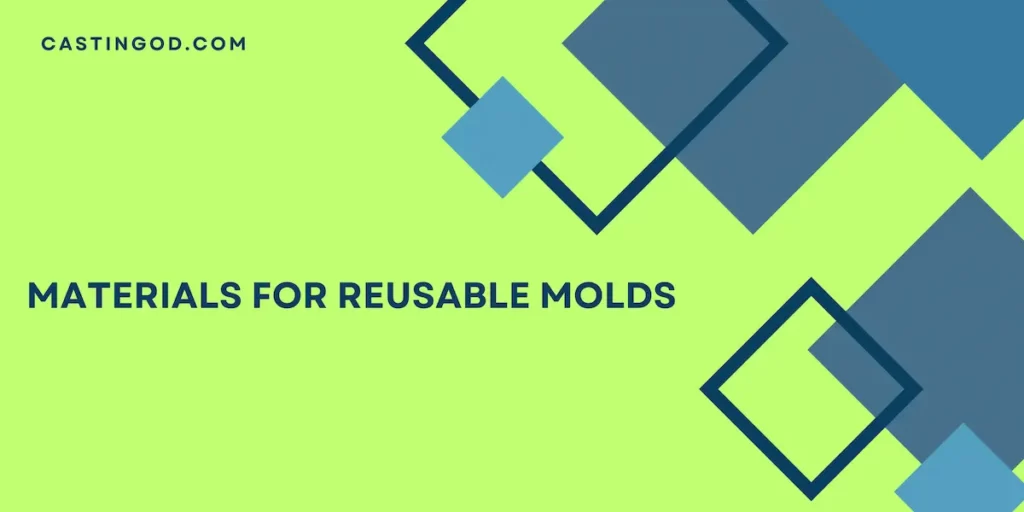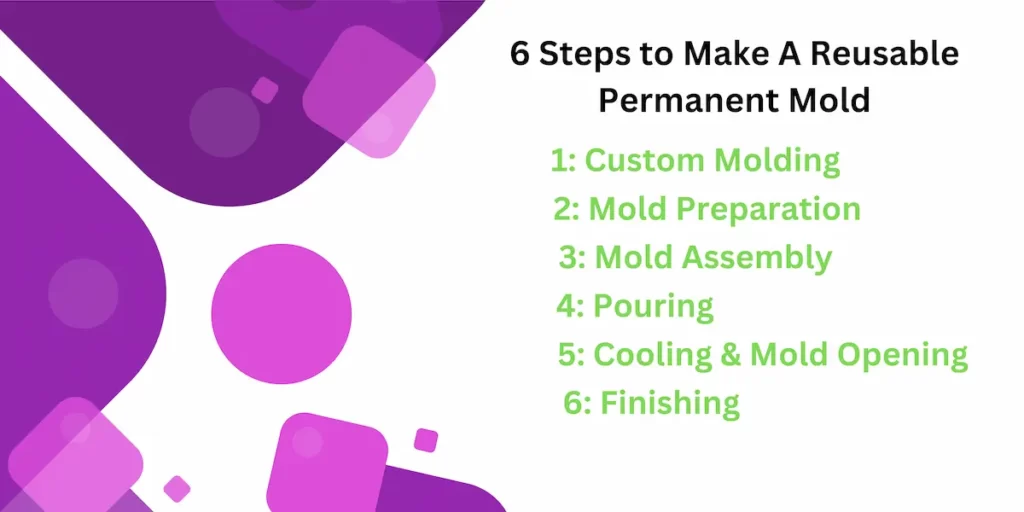Cast aluminum molds are essential to the industrial sector because they provide high-quality products for various purposes. Using and maintaining them according to recommended practices is necessary to protect their longevity and efficiency.
One of the most important steps in aluminum die-casting is the creation of molds. Die casting uses a mold as a “container” to hold the molten aluminum while also defining its ultimate shape. As a result, the accuracy of the mold will improve the final product’s quality. The die casting process will cause a defective object if the mold has defects.
Also read: How to make die molds? Reusable Aluminum Casting Molds?
Molds are usable and come in both permanent and temporary types. We give some of the most popular molds for casting aluminum below:
- Sand casting
- Ceramic mold
- Permanent mold casting
- Die casting molds
- Shell mold
- Plaster mold casting
- Graphite casting molds
Material Selection for Cast Aluminum Molds

It is important to choose the materials for cast aluminum molds to be reliable. Incorrect material selection may end up in poor dimensional precision, surface polish, and longevity, which can raise costs and reduce productivity.
It can produce molds using a wide variety of materials. The list below includes some of the most typical materials used to create cast aluminum molds.
- Steel
- Cast iron
- Ceramic
- Graphite molds
Factors to Consider When Selecting Materials for Cast Aluminum Molds
We must consider several factors when choosing mold material for cast aluminum molds, such as
- Material Properties
- Manufacturing Requirements
- Cost Considerations
- Longevity and Durability
1: Material Properties
The mold’s material qualities need to be appropriate for the particular purpose. One must also consider machinability, heat conductivity, and strength when selecting materials for cast aluminum molds..
2: Manufacturing Requirements
When choosing materials, one must consider manufacturing requirements such as production volume, mold complexity, and manufacturing processes..
3: Cost Considerations
It is important to consider both the material’s cost and the total cost of molds production when choosing materials. Higher-quality materials may cast more, but they might cause mold that is more productive and durable.
4: Durability
When choosing materials, it is essential that you consider the mold’s lifetime and durability. It is necessary for the mold to withstand the particular application and production environment to ensure the mold’s durability and dependability.
Creating a Permanent Mold for Aluminum Casting
Permanent mold casting is another form of metal casting that uses reusable molds. Permanent molds can make hundreds or even thousands of identical parts, compared to other casting techniques like sand casting and investment casting, which use disposable molds that have to be discarded after a short time.
There is a proper casting technique for every project. Permanent mold casting has a wide range of benefits for non-ferrous castings with medium-to-high volumes.
Process of Casting Permanent Molds
Permanent mold casting involves a durable metal mold, often constructed of steel, cast iron, or dense cast iron. The cost of making the mold can be high, but because it is long-lasting, we can use it multiple times. The process is extremely cost-effective because of the long mold life.
Permanent mold casting is most often used to shape nonferrous metals such as aluminum, magnesium, and copper alloys. Graphite molds can cast iron, steel, and some other metals.
Before putting in the molten material and securing the mold shut, we often put a permanent metal core within the permanent mold. After cooling to a specified temperature inside the mold, the molten material solidifies into the required part shape.
After opening the mold, we take out the part and then carry out the finishing work.. When we open the mold, we take out the part and then carry out the finishing work.. The process eliminates extra castings from the opening area.
6 Steps to Make A Reusable Permanent Mold

There are typically six steps involved in permanent mold casting:
1: Custom Mold
Making a custom mold is the first step in the permanent mold casting process. We carefully made each part of the mold from separate metal blocks, ensuring that it will fit together perfectly and open and close precisely and smoothly. We must also include a gate area in the mold to allow molten materials to get in properly.
2: Mold Preparation
Usually, the mold is prepared to a temperature between 300 and 500 degrees Fahrenheit before casting. Metal flows more smoothly and has fewer defects in heated molds. Additionally, preheating decreases the chance that hot, molten metals will harm the mold itself.
You can add a thin layer of sodium silicate to the inside mold cavities to extract the cast item quickly and preserve the mold from damage..
3: Assembly of the Mold
Permanent casting molds often have two components, including the two mold sections and additional cores required to create intricate details. We must seal and attach every component together before pouring the molten metal inside.. Machines are usually used to carry out this.
4: Pouring
Molten material slowly pours into the mold via a gated area known as a sprue.
5: Cooling and Mold Opening
The molten metal may slowly cool and solidify inside the mold. We must remove solid metal casting from the mold before it cools completely to avoid the mold from breaking because many metals considerably shrink in size in the cooling process.
6: Finishing
We will remove the last round of scrap metal from the cast metal component.
3D Printing Molds for Aluminum Casting
Using 3D printing in today’s manufacturing has opened a world of opportunities. Aluminum casting has undergone a revolution because of 3D printing’s capacity to produce molds with detailed shapes and complex geometries.
We use a replica of the finished part as the template to make the mold. The mold material, such as silicone or sand, applies to the pattern after we have placed it in a container. Depending on the process used, we either pull out or destroy the pattern, which leaves a cleanly specified hollow in the mold material. To create the castings, we later injected liquid metal into this cavity.
The creation of designs using 3D printing has become a very useful and cost-effective process. In contrast to traditional pattern making, 3D printing enables digital casting design using CAD software, and a variety of printing methods can create the pattern.
SLA is a popular photopolymerization technology because it creates smooth, finely detailed parts, which create smooth, finely detailed molds. Additionally, several SLA material producers provide special wax-containing casting resins for direct investment casting. These components can be neatly “burnt out” of a finished mold, preserving the mold itself for casting.
Advantages and limitations of 3D-printed molds
3D printed molds have both advantages and limitations.
Advantages
- 3D-printed molds are quicker and more affordable than modern pattern- and mold-making techniques.
- High equipment costs for direct-printing techniques like binder jetting
- Can produce intricate geometries, multi-core parts, and other challenging designs
- The relatively limited build volumes of popular technologies like SLA restricted mold size and FDM.
- Less material waste because of the removal of some production steps
Disadvantages
- It needs experience with CAD software
- You can use it with conventional methods.
Steps Involved In 3D Printing Aluminum Casting Molds

Below, we provide the step-by-step process of 3D printing aluminum casting molds..
1: Patternmaking
A manufacturer needs to make a model of the desired die casting mold design on 3D printer before starting the metal casting procedure. This pattern is necessary for creating the aluminum casting molds. It comprises wood, foam, plastic, or wax. A popular way of producing patterns today is 3D printing, which enables designers to make precise patterns straight from CAD software tools.
2: Moldmaking
The second step is to create aluminum casting molds, which may or may not be reusable. It often created molds that are not reusable using 3D printing. They also use 3D printing to create molds for aluminum casting, but these molds are often not reusable..
3: Melting and Pouring Molten Metal
We heated the metal in a furnace during this step until it melts. When the metal is ready, the producer puts it into the cavity of the mold and lets it cool and solidify.
4: Mold Removal and Cleaning
When the metal solidifies and cools down, we took the sections from the mold. Vibrations can achieve this during a shakeout process by using ejector pins, depending on the type of mold. We then removed the extra material from the pieces, including vents, gates, and feeders. In order to get the desired final shape, the pieces are then filed, grated, machined, or sandblasted.
5: Ensuring Mold Reusability and Maintenance
High-quality, reliable injection molded products require efficient and regularly maintained aluminum casting molds. The cooling action of the cavity imprint produces a quick cycle time and high-quality part.. To guarantee a high-quality mold, proper tooling and precise manufacturing are necessary.
6: Mold Testing regularly
It is necessary to regularly monitor mold for any symptoms of wear or damage, such as cracks, erosion, or warping.
Follow the Cleaning Techniques and Recommendations
A thorough cleaning of the mold is required to avoid the accumulation of dirt, particles, or waste that could harm the mold’s surface finish and functionality.
Make Sure That Repairs and Restorations Are Completed
We must repair properly molds in order to be restored to their initial state after being damaged or worn. The type and mold damage will determine the restoration method.
If a mold is seriously damaged, restoration methods like welding or machining might be required. Trained experts must perform these procedures.
Cold Storage Methods
Someone must store properly the mold to avoid any harm or deterioration while being stored. The mold needs to be protected from dust and debris while being stored in a cool, dry, and tidy environment.
Safe Mold Handling Methods
We must follow safe handling processes to avoid damage or harm while handling. The mold must be handled carefully, transported using the proper lifting and safety gear, and not subjected to affects or shocks.
Following these recommendations can help extend the life and dependability of cast aluminum molds as well as assure the consistent, high-quality casting of parts.
Regular testing, maintenance, and repair, besides safe handling and storage, can improve mold performance and boost output while cutting costs.
Conclusion
Reusable aluminum casting molds provide several advantages over single-use molds. They are more affordable, more efficient, and easier to maintain and repair. They consequently grow into a more popular choice for manufacturers in several industries.









